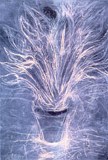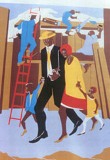This article may not be published or printed elsewhere without the express permission of IFAR
September 11th:
ART LOSS, DAMAGE, AND REPERCUSSIONS
Proceedings of an IFAR Symposium on February 28, 2002
The Art Lost by Citigroup on 9/11 page 2
by Suzanne F. W. Lemakis
But to return to the works that were lost. The dining rooms had, in addition to paintings and prints, some first-rate English and American antique furniture and Asian porcelains. (We are fortunate that a Tang Dynasty camel was among the works relocated.) The most expensive painting in the collection was a large mural that was installed in one of the dining rooms. This mural had been relocated to Seven World Trade from Salomon's previous offices. The mural depicted Wall Street, including some Salomon bankers. The work, purely decorative, by an unknown designer, was commissioned from a famous wallpaper company. This mural was very beloved by the employees, so its loss is deeply regretted.
Among lost paintings were some good works by artists such as Carl Schrag, Louis Bouche, John Heilker, William Thon and a number of paintings by American Realists painted in the 1980s. Like most corporate collections, three-quarters of the artworks consisted of prints, both nineteenth-century decorative American prints and contemporary works. In fact, over half the print collection consisted of decorative American prints purchased from the Kennedy, Hirschl & Adler, Graham Arader and Donald Heald galleries. Among the prints lost were a number of plates from Hudson River Portfolio, John Backman's Bird's Eye View of New York and Brooklyn, 1851, George Caleb Bingham's engravings of the Country Election and Stump Speaking, and a number of Currier and Ives lithographs. Most of these prints were originally printed in large numbers, many are replaceable, but their loss is very sad.
Among the contemporary prints lost were works by Alex Katz, Bryan Hunt, Wolf Kahn, and a wonderful Jim Dine series (Fig. 3) that decorated the cafeteria. There had been no effort to create a collection of contemporary prints, and the collection had not been expanded until 1999, when I placed five Jacob Lawrence (Fig. 4) and two Romare Bearden prints in the executive area. These, too, were lost.
In the private offices there were the expected inexpensive corporate office prints by artists that are known to corporate curators but not to art historians. Every corporate collection seems to have some of these landscapes and floral images done in etching, lithography, and screenprinting, and they serve their purposes in the offices.
Altogether, one thousand one hundred and thirteen works of art were lost by Citigroup on 9/11.
The lessons learned were very simple: keep good records and keep them off site. I am fortunate that we are in the process of getting an up-to-date imaged-based system, so that tracking the collection will be easier. I initiated upgrading of our database and 9/11 has made the upgrade urgent. One always anticipates for thefts and fires, but there was never any thought that one terrorist act would result in the loss of the whole building.
A final note: Since the IFAR Symposium, the rare and wonderful Edward Curtis photograph that I showed in my talk has been donated by Citigroup to the Smithsonian Museum of the American Indian. The initial contact for this donation was made at the Symposium.
Finis
To read transcripts of the other talks, please click on the desired topic below.
| Public Art at the World Trade Center -Saul S. Wenegrat | Response from the Insurance Industry -Dietrich von Frank |
| The World Trade Center Memorial, 1993 -Elyn Zimmerman | The Insurance Adjuster's Role -Gregory J. Smith |
| The Artist Residency Program in the Twin Towers -Moukhtar Kocache |
The Downtown Institutional Impact -John Haworth |
| The Art Lost by Citigroup on 9/11 -Suzanne F.W. Lemakis |
The Heritage Emergency National Task Force - Lawrence L. Reger |

